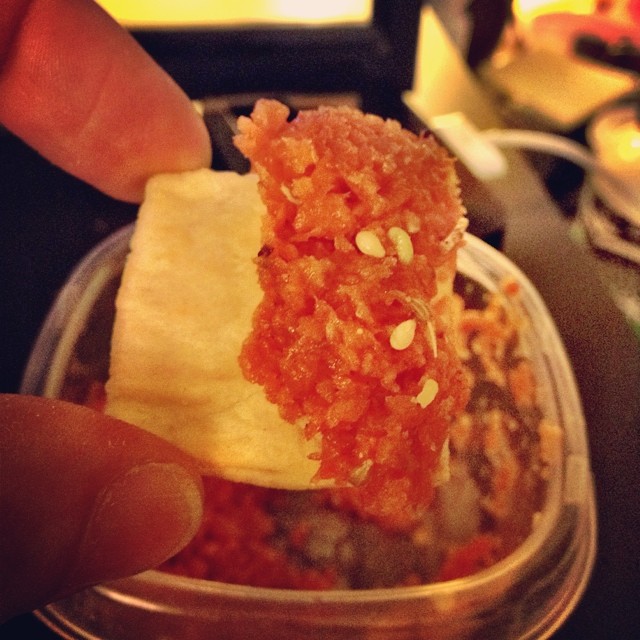[NOTE: Edited July 6, 2014 to include changes in cooking and processing the carrots after making this a few more times]
As I’ve mentioned previously, I have an Omega juicer. Using it results in vegetable pulp – the fibrous residue of harder vegetables such as carrots, beets, and leafy greens. I’ve tried a number of recipes purporting to make tasty treats from this pulp, but so far have found none good enough that I wanted to finish the results.
While kale and celery pulp are rather stringy and unappetizing, I really wanted to find a use for the carrot pulp. I started adding to my blended breakfast cantaloupe (frozen in single servings, defrosted and mixed with yogurt) and crockpot oatmeal.
Finally I was inspired by my localvore caterer/meal CSA/event service Cuisine en Locale when they served a mezze plate which included a Turkish carrot dip. Online searching led me to several versions (such as this from local chef Ana Sortun), from which I took ingredient ideas and then winged it with my kitchen contents:
The recipe:
Carrot Pulp Mediterranean Dip
- Pulp/shreds from one pound of carrots
- 2 TBS olive oil (I used Trader Joe’s Garlic Oilive Oil)
- 1 TBS vinegar (I used Balsamic, but white will work)
- 1 TSP ground cumin
- 1 TSP ground ginger
- 1+ TSP harissa, depending on desired heat (if you have it – I didn’t, so used other spice blends that included cayenne and chili – see below)
- 1+ TSP of other Middle Eastern spice blends as available. I bought a set of 4 spice blends from Trader Joe’s and used ras el hanout and pilpelchima
- Dukkah (also from TJ’s) for topping when served
In a pot cover the carrot pulp with water. Bring to a boil, then reduce heat and simmer for 10 minutes.
Steam the carrot pulp over gently boiling water for 10-12 minutes. I used an steamer basket in a Calphalon pot, but you can use a strainer that fits in a pot, a bamboo steamer in your wok, or whatever you have that lets you steam the carrot pulp covered.
Strain off the water – if you do not have a fine sieve you may need to line a larger strainer with cheesecloth, or just carefully pour off the excess while pushing back the carrots with a spatula. Return the cooked carrot pulp to the pot over low heat and stir to keep from burning while more of the water evaporates.
Put the carrot pulp into a bowl and let cool a bit.
Stir in the olive oil and vinegar, and all of the spices except the dukkah. If you do not have a food processor you can skip the next step, but I recommend it for better texture.
Spoon the carrot mixture into a small food processor. Add a couple ounces of liquid – juice from the juicing process or water. Blend the mixture until mostly smooth, stopping to push it back down towards the blade as necessary. It will be fairly thick.
Taste and adjust as necessary.Refrigerate in a covered container overnight.
Sprinkle with dukkah before serving with pita bread or chips.
Notes:
- I’m not big on salt, but you might want to add some to the carrots after cooking.
Next time I may blend the cooked carrots for a smoother texture, but I didn’t want to put them hot into the blender and didn’t bother later.


Hey Betty! Just a suggestion, but maybe it would be better to decrease the water so that you don’t have to strain it off. When you boil carrot pulp in the water you’ll lose a lot of the flavor, especially seeing as the juice is removed and you’re using ground carrot which has a great surface area to leach flavor into the water. I would suggest trying it with just enough water to prevent the carrot from scorching while still allowing it to cook. Even better may be to use a flavored liquid, like green or jasmine tea. I have to pick some carrots from a greenhouse I work it, maybe I’ll juice them and give my idea a shot and let you know the result.
Yes, I was less than satisfied with trying to drain the carrots. I’m thinking maybe I will try steaming them in a basket next time – I can always add another liquid if they are too dry afterward.